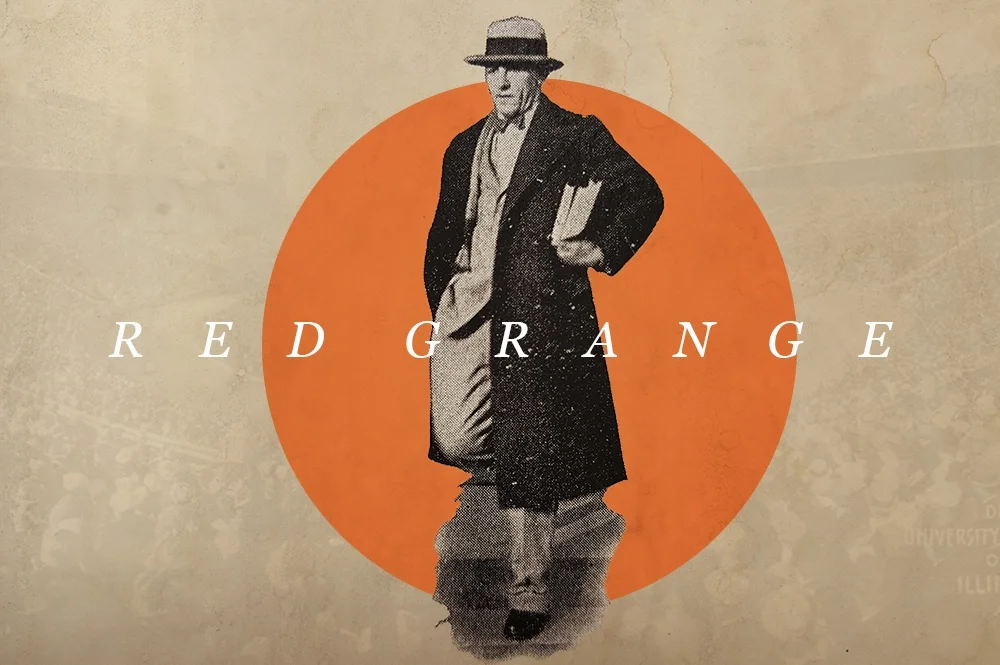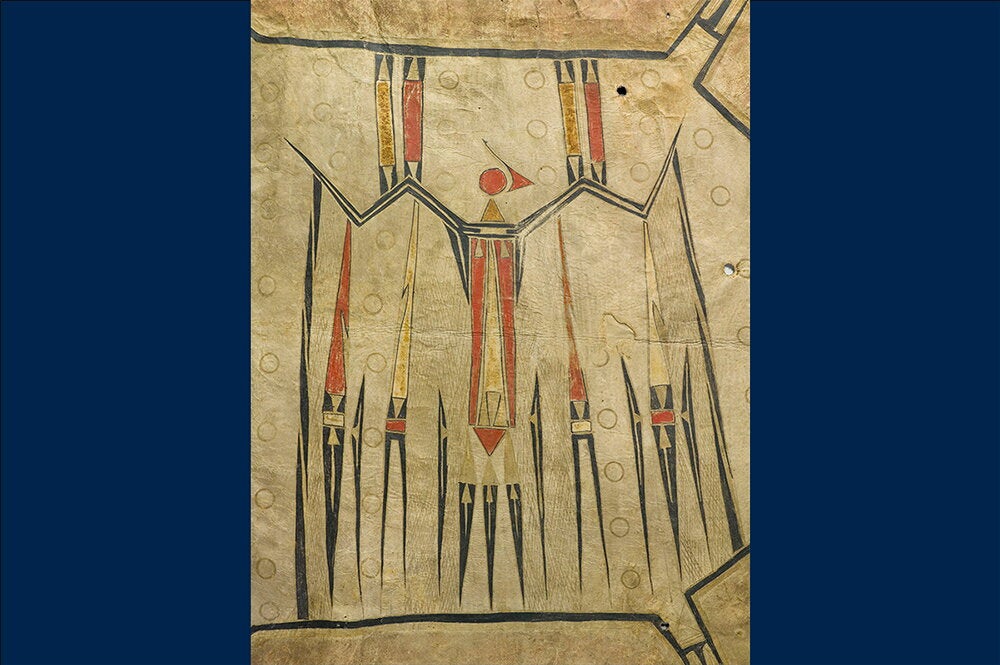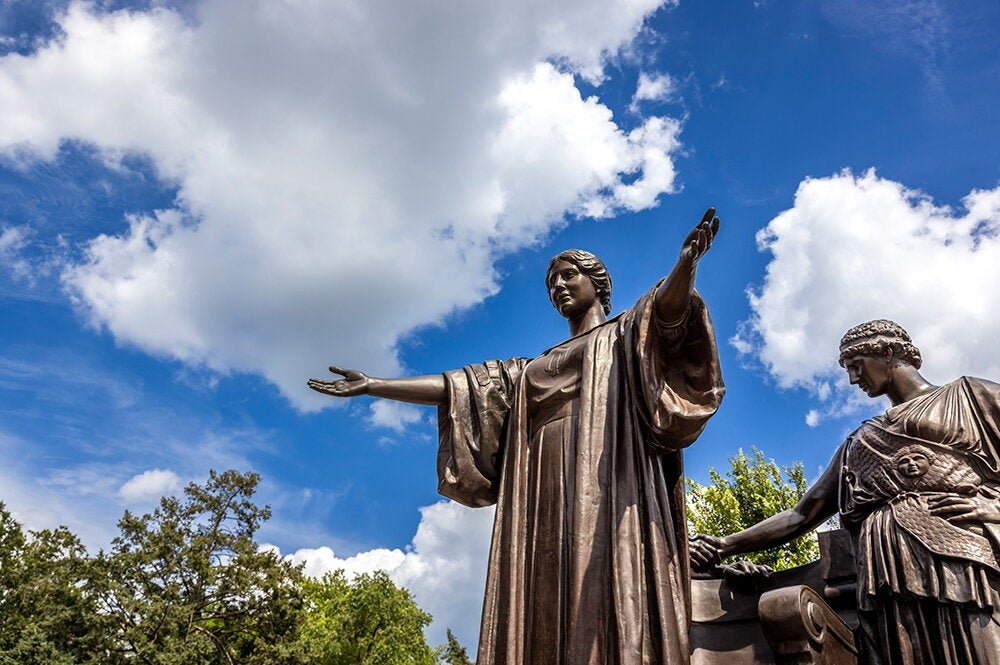

Editor's note: This story first appeared in the Fall 2016 issue of LAS News magazine. We're resharing it in advance of the Memorial Stadium Rededication Game, held 100 years after the Memorial Stadium Dedication Game in which Red Grange scored four touchdowns in an historic performance against Michigan.
Here’s some Harold “Red” Grange trivia that might stump even the most devout football fan: What did he study at the University of Illinois?
The answer: history. He transferred to the College of Liberal Arts & Sciences from the College of Commerce with stated intentions to major in the subject. As time revealed, however, a history degree was not meant to be.
Grange never graduated from Illinois. He played his last game for Illinois on Nov. 21, 1925, a 14-9 Illini victory over Ohio State. It was also his last act as an Illinois student. The next day he signed a lucrative player’s contract with Chicago Bears owner (and former Illinois player) George Halas.
By many accounts Grange went on to save professional football, but his early departure from college—he carried a 3.14 grade point average but was 44.5 credits short of graduating—also triggered a national debate that went to the heart of sports and the meaning of higher education.
“No more football, no more college,” the Cleveland Plain Dealer wrote two days after Grange’s last game. “Indeed, it is even now Harold’s own business. But in making the decision to quit he has undoubtedly harmed college football, and has done a disservice to the institution which he has represented on the athletic field.”
A few months later, an article by former Illinois student Frazier Hunt appeared in Cosmopolitan. Hunt, clearly dismayed by Grange’s decision, asked Illinois students how they felt about the star’s early departure from college.

“We come to college to learn how to make money, don’t we?” one student told him. “Well, Red has learned how. Why shouldn’t he practice his profession of football?”
Grange’s coach at Illinois, the legendary Robert Zuppke (for whom the field at Memorial Stadium is named), voiced concern about the implications of Grange’s decision on higher education itself.
“There are still dreamers,” Zuppke told Hunt. “But they are deadened by the thought embodied in the phrase, ‘What is there in it for me?’—which is the great American slogan now. The technical and commercial colleges are sponging up the ideals that were fostered by the colleges interested in the humanities—the fine and gentle things.”
At that point, the dust from Grange’s departure was still settling. Then-Illinois President David Kinley encouraged Grange to stay in school, according to Winton Solberg, professor emeritus of history who’s written extensively about the university. Kinley, perhaps dismayed by Grange’s decision, later rejected a proposal for a Red Grange statue by Memorial Stadium. His decision stood until 2009, when a 12-foot bronze statue of Grange was placed prominently outside as part of the stadium’s renovation.
Zuppke and Grange had a falling out. Grange recounted in his autobiography how his coach pleaded with him to stay away from professional football.
“You get paid for coaching, Zup, why should it be wrong for me to get paid for playing?” Grange told him.

A few weeks after Grange’s decision, the pair attended an Elks Club banquet during which Zuppke publicly questioned Grange’s decision to join the professional ranks. Grange was so upset by Zuppke’s comments that he left the speaker’s table while his former coach was still talking.
Despite the uproar, Grange expressed few regrets about his decision. Within a few months, he had earned a reported $100,000 (albeit during a particularly grueling football tour) and, according to newspaper accounts, bought his father a new house back in Wheaton, Illinois.
“I haven’t any apologies to make. I’m not ashamed of a thing I’ve done,” Grange told the Newspaper Enterprise Association in early 1926. He added: “I am inclined to think the real reason many football coaches object to professional football is because they fear it will detract from the college game. They need have no such fears. The big attraction in football will always be the university, college and school game, and spirit.”
His attitude appeared to change little later in life, even after a knee injury in 1927 robbed him of some of his famed ball-carrying ability. He starred in films (One Minute to Play (1926), Racing Romeo (1927), and a serial series, The Galloping Ghost (1931), and his fame rivaled that of Babe Ruth. Grange later worked as a sports announcer, and he enjoyed success in real estate and insurance. He moved to Florida, where he bought an orange grove and ultimately retired (Grange died in 1991).
Grange also reconciled with the University of Illinois. He served on the university’s board of trustees in the 1950s, and, in 1974, a half a century after he played, he drew thousands of people for Red Grange Day, on the 50th anniversary of the dedication of Memorial Stadium.
By then, Grange had long since made peace with his former Illinois coach. The artistically-inclined Zuppke was so moved by coaching the player that in the 1940s he painted a portrait of Grange.
“Grange was a genius of motion. I once made a trip to Kaibab Forest on the north rim of the Grand Canyon, and as a deer ran out of the grass plains, I said, ‘There goes Red Grange,’” Zuppke told Esquire magazine in 1936. “The freedom of movement of the deer was so similar to Red’s.”
Grange later gave the portrait to Patrick Hayes, former senior director of the U of I Alumni Association and former senior director of development at the College of LAS. Hayes befriended Grange and his wife, Margaret (“Muggs”), later in their lives.
Hayes detected no regret from Grange regarding his decision to leave Illinois. "I think Red was content with his own circumstances,” Hayes told LAS News. “Still, he fully understood and valued the doors which can be opened through education."
That’s evident in Grange’s own words. In 1938, according to an Associated Press report, Grange attended a dinner for a celebrated football star, Chicago’s 19-year-old Bill De Correvont, who was headed to play for Northwestern University. During the proceedings, Grange, his football career by then complete, took the young man aside for a private moment.
He told him this: “Graduate.”


